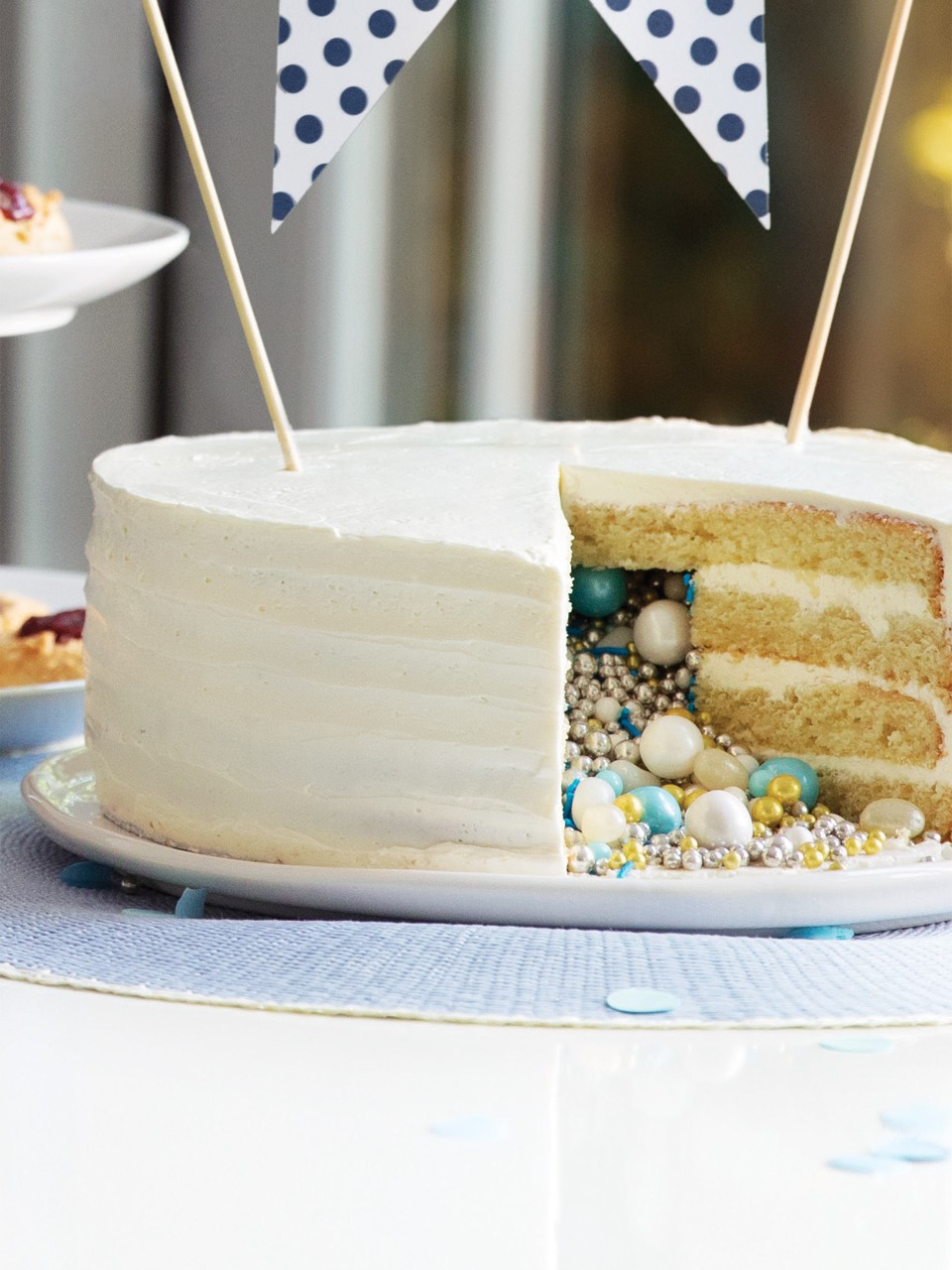We use cookies and similar technologies to improve user experience, and analyse activities and performance. For more information, please see our Privacy Policy. 
Recipe Detail Page


Celebration Explosion Cake
Autumn 2018
How does a simple layer cake become even more fun? When there’s a candy surprise inside, of course—it’s like an edible piñata made out of moist vanilla cake and luscious buttercream. The buttercream is a little more work than a basic icing but the not-too-sweet, creamy texture offsets the candies perfectly (see TIP). This looks just like a regular cake on the outside until a pile of colourful candies tumbles out of the centre as the first slice is cut. Choose colours to fit a party theme, team colours or use every colour of the rainbow. A mix of small candies (Skittles, M&Ms, mini candy-coated chocolate chips) and sprinkles works well. If you like, tint the cake batter with food colouring for even more splash. Be sure the first slice you cut is a large wedge to get the full effect of the candy explosion—and make sure someone has the video rolling to capture the excitement.
Serve 12
CAKE
3 cups (750 mL) all-purpose flour
1 tbsp (15 mL) baking powder
1 tsp (5 mL) salt
½ tsp (2 mL) baking soda
1 cup (250 mL) unsalted butter, softened
1¾ cups (425 mL) granulated sugar
4 large eggs, at room temperature
1 tbsp (15 mL) vanilla extract
1¾ cups (425 mL) buttermilk
Food colouring (optional)
VANILLA BUTTERCREAM
6 large egg whites, ¾ cup (175 mL)
1½ cups (375 mL) granulated sugar
½ tsp (2 mL) salt
2 tsp (10 mL) vanilla extract
2½ cups (625 mL) unsalted butter, cut into ½ inch (1 cm) cubes, softened
FILLING
1¼ cups (310 mL) assorted small candies (approx.)
1/4 cup (60 mL) to ½ cup (125 mL) sprinkles or other tiny candy decorations (approx.)
1. Preheat oven to 350°F (180°C).
2. Grease and flour the sides of two 9-inch (23‑cm) round cake pans and line bottoms with parchment paper.
3. Combine flour, baking powder, salt and baking soda in a bowl using a whisk. In a large bowl, using electric mixer, beat butter and sugar until very light and fluffy. Beat in eggs, 1 at a time, beating well after each addition and scraping down sides of the bowl often. Beat in vanilla. Using a rubber spatula, stir in flour mixture alternately with buttermilk, making 3 additions of flour and 2 of buttermilk.
4. Tint batter with food colouring, if desired. Divide batter equally and spread into prepared pans, smoothing tops.
5. Bake for about 40 minutes or until tester inserted in the centre comes out clean. Let cool in pans on a rack for 15 minutes. Gently run a knife around edges, then invert onto wire racks and peel off paper. Let cool completely. (Cakes can be stored, well wrapped, in an airtight container at room temperature for up to 1 day.)
6. For the vanilla buttercream, whisk together egg whites, sugar and salt in a metal bowl of a stand mixer or a large heatproof bowl (to use a hand mixer). Set bowl over a saucepan of simmering water (do not let bottom of the bowl touch the water) and heat, whisking constantly, for about 3 minutes or until sugar is dissolved and mixture is warm to the touch. Attach to mixer with whisk attachment (or beaters for hand mixer) and beat on medium speed for about 20 minutes or until thick and completely cool. Beat in vanilla. Add butter, about 5 cubes at a time, beating constantly and making sure butter is incorporated between each addition, until buttercream is fluffy and smooth (as you add butter the mixture will thin out then thicken up and get creamy again).
7. To assemble cakes, cut each cake layer in half horizontally. Set 1 bottom half of a cake layer aside with the flat-side up for the top. Use a 3-inch (8-cm) round cookie cutter to cut a circle from the centre of the remaining 3 layers and remove, leaving a ring (the cut-out circles are for snacking).
8. Place 1 bottom cake layer ring with the cut-side up on a cake plate. Spread about ⅔ cup (150 mL) buttercream on the cake. Top with another cake layer, aligning the holes in the centre, and spread with buttercream, then top with the third layer. Spread a thin layer of buttercream inside the hole in the centre. Refrigerate for 5 to 10 minutes to set (leave remaining buttercream at room temperature).
9. Spread top cake layer with ⅔ cup (150 mL) buttercream. Combine candies and ¼ cup (60 mL) sprinkles in a bowl, then spoon into the hole in the centre of the cake up to the top edge. Shake the cake gently as you fill to help the candies pack down and fill up any air pockets (you may have some extra). Top with remaining cake layer so the smooth side is on top and press lightly.
10. Spread sides and top of cake with a thin layer of buttercream frosting for a crumb coat. Refrigerate for 15 minutes. Spread a thicker layer of buttercream on sides and top and spread or decorate with piped buttercream, as desired. Garnish with additional candies and sprinkles, if desired.
11. Refrigerate until it is just set, about 1 hour, or for up to 1 day. If cake is cold, let warm at room temperature for about 30 minutes before serving. Cut into slices with a large, warmed knife. Use a large cake lifter to swiftly remove the slice of cake and watch the candies explode.
TIP If you prefer to use a simple butter icing rather than the buttercream, you’ll need about 5½ cups (1.375 L) icing.
Serve 12

